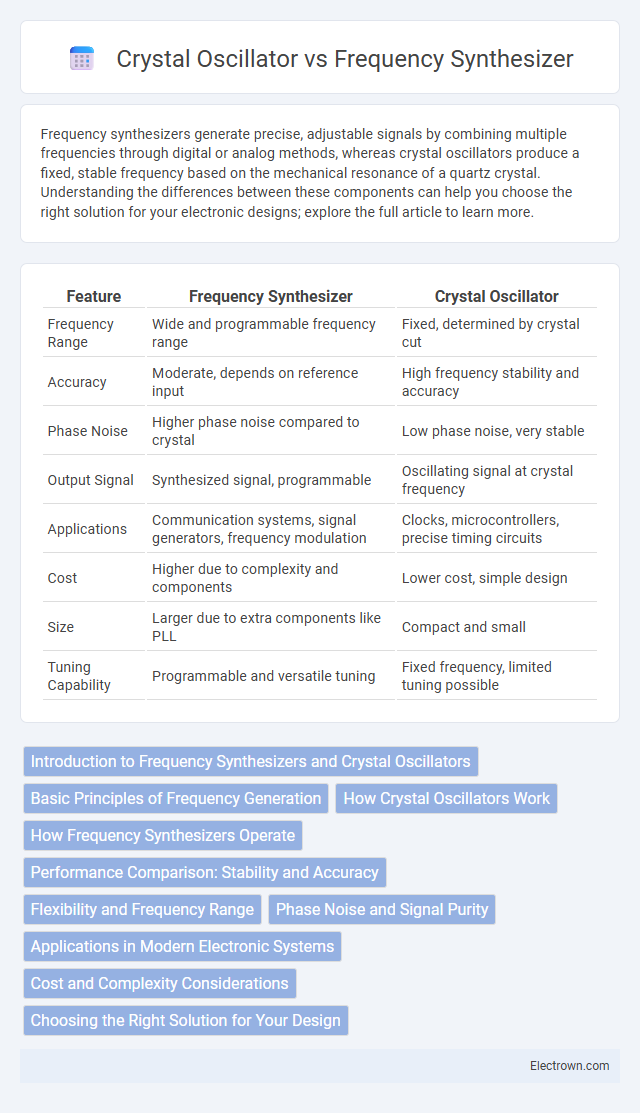Frequency synthesizers generate precise, adjustable signals by combining multiple frequencies through digital or analog methods, whereas crystal oscillators produce a fixed, stable frequency based on the mechanical resonance of a quartz crystal. Understanding the differences between these components can help you choose the right solution for your electronic designs; explore the full article to learn more.
Table of Comparison
| Feature | Frequency Synthesizer | Crystal Oscillator |
|---|---|---|
| Frequency Range | Wide and programmable frequency range | Fixed, determined by crystal cut |
| Accuracy | Moderate, depends on reference input | High frequency stability and accuracy |
| Phase Noise | Higher phase noise compared to crystal | Low phase noise, very stable |
| Output Signal | Synthesized signal, programmable | Oscillating signal at crystal frequency |
| Applications | Communication systems, signal generators, frequency modulation | Clocks, microcontrollers, precise timing circuits |
| Cost | Higher due to complexity and components | Lower cost, simple design |
| Size | Larger due to extra components like PLL | Compact and small |
| Tuning Capability | Programmable and versatile tuning | Fixed frequency, limited tuning possible |
Introduction to Frequency Synthesizers and Crystal Oscillators
Frequency synthesizers generate a range of frequencies from a single reference frequency using phase-locked loops, mixers, and dividers, providing high-frequency stability and flexibility for communication systems. Crystal oscillators rely on the piezoelectric properties of quartz crystals to produce a stable, precise frequency, widely used in clocks and microcontrollers for consistent timing. Your choice between these depends on the application's need for frequency agility versus simplicity and ultra-low phase noise.
Basic Principles of Frequency Generation
Frequency synthesizers generate precise frequencies by using algorithms and reference signals, typically combining phase-locked loops (PLLs) with voltage-controlled oscillators (VCOs) to produce a wide range of output frequencies from a single reference input. Crystal oscillators rely on the piezoelectric effect in quartz crystals to produce a stable and accurate fundamental frequency through mechanical resonance. While crystal oscillators offer excellent frequency stability and low phase noise, frequency synthesizers provide greater flexibility and tunability for complex communication systems.
How Crystal Oscillators Work
Crystal oscillators generate precise frequencies by exploiting the piezoelectric properties of quartz crystals, which mechanically vibrate when an electric field is applied. These vibrations produce a stable oscillation frequency determined by the crystal's cut and size, offering excellent frequency stability and low phase noise. Your choice of a frequency source can directly impact the accuracy and reliability of electronic circuits, making crystal oscillators ideal for applications requiring stable reference signals.
How Frequency Synthesizers Operate
Frequency synthesizers operate by generating a range of frequencies from a single reference frequency using techniques like phase-locked loops (PLLs), voltage-controlled oscillators (VCOs), and frequency dividers. These components work together to produce highly stable and precise signals essential for communication systems, RF devices, and signal processing. Your choice between a frequency synthesizer and a crystal oscillator depends on the need for frequency agility versus fixed frequency stability.
Performance Comparison: Stability and Accuracy
Frequency synthesizers offer superior stability and accuracy compared to crystal oscillators due to their ability to generate precise frequencies with minimal phase noise and low jitter, essential for modern communication systems. Crystal oscillators, while inherently stable because of their quartz resonators, are limited by temperature variations and aging effects that degrade frequency accuracy over time. Synthesizers incorporate phase-locked loops and digital control, allowing dynamic frequency adjustments and enhanced long-term stability beyond the fixed frequencies achievable by crystal oscillators.
Flexibility and Frequency Range
Frequency synthesizers offer superior flexibility by generating a wide range of frequencies through programmable components, making them ideal for applications needing multiple output frequencies. Crystal oscillators provide highly stable and precise frequencies but are limited to fixed frequencies determined by the crystal's physical properties. Your choice depends on whether you prioritize broad frequency range and adjustability (frequency synthesizer) or exceptional frequency stability (crystal oscillator).
Phase Noise and Signal Purity
Frequency synthesizers generally exhibit higher phase noise compared to crystal oscillators due to the complexity of their signal generation mechanisms, involving phase-locked loops and frequency dividers. Crystal oscillators maintain superior signal purity with lower phase noise levels, attributed to the stable resonance of quartz crystals, making them ideal for applications demanding precision timing and low jitter. Despite this, frequency synthesizers offer greater frequency agility but often at the cost of increased noise and reduced signal purity relative to crystal oscillators.
Applications in Modern Electronic Systems
Frequency synthesizers enable precise and programmable signal generation essential for communication systems, radar, and digital devices, offering flexibility in frequency selection. Crystal oscillators provide highly stable and low-noise reference signals crucial for timing applications, microcontrollers, and GPS modules. Your choice depends on whether you need fixed, ultra-stable frequencies or adaptable frequency outputs for complex modern electronic systems.
Cost and Complexity Considerations
Frequency synthesizers typically involve higher initial costs and greater design complexity due to their reliance on phase-locked loops and digital signal processing components, making them suitable for applications requiring multiple frequencies or fine frequency resolution. Crystal oscillators, by contrast, offer lower cost and simpler circuit design, providing stable and precise frequency output ideal for single-frequency needs and cost-sensitive projects. Your choice between these components depends on budget constraints and the required frequency flexibility for your application.
Choosing the Right Solution for Your Design
Frequency synthesizers offer precise frequency control and flexibility across a wide range of frequencies, making them ideal for complex, multi-frequency applications in communication systems. Crystal oscillators provide excellent frequency stability and low phase noise, best suited for applications requiring a fixed and highly stable frequency reference such as timing and clock generation. When choosing the right solution for your design, consider whether frequency agility or long-term stability is the primary requirement to optimize performance and cost-effectiveness.
Frequency Synthesizer vs Crystal Oscillator Infographic

 electrown.com
electrown.com